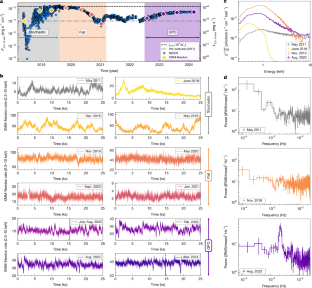超大质量黑洞最内层轨道附近的毫赫振荡
IF 48.5
1区 综合性期刊
Q1 MULTIDISCIPLINARY SCIENCES
引用次数: 0
摘要
最近时域调查的发现打破了我们对物质如何吸积到超大质量黑洞(SMBHs)的预期。在SMBHs周围不断增加的短时间尺度的重复事件,包括最近发现的准周期爆发1,2,3,4,5,使人们对SMBHs周围的恒星质量伴星和毫赫频率引力波事件的前身产生了进一步的兴趣。在这里,我们报告在一个活跃吸积的SMBH 1ES 1927+654中发现了一个非常显著的毫赫准周期振荡(QPO),该黑洞从2018,7开始经历了一次主要的光学、紫外线和x射线爆发。QPO于2022年被发现,周期约为18分钟,对应于小于10引力半径的相干运动,比典型的准周期性喷发更接近SMBH。周期在2年内减少到7.1分钟,并呈减速期演变(\(\ddot{P}\)大于零)。据我们所知,这种演化从未在SMBH QPOs或恒星质量黑洞的高频QPOs中看到过。在没有稳定的质量转移来抵消角动量损失的情况下,调用恒星质量伴星轨道衰变的模型很难解释周期演化,而且缺乏对恒星质量黑洞QPO的直接模拟意味着许多不稳定模型不能解释1ES 1927+654中QPO的所有观测性质。未来的x射线监测将测试这些模型,如果它是一个恒星质量轨道器,激光干涉仪空间天线(LISA)应该探测到它的低频引力波发射。本文章由计算机程序翻译,如有差异,请以英文原文为准。


Millihertz oscillations near the innermost orbit of a supermassive black hole
Recent discoveries from time-domain surveys are defying our expectations for how matter accretes onto supermassive black holes (SMBHs). The increased rate of short-timescale, repetitive events around SMBHs, including the recently discovered quasi-periodic eruptions1–5, are garnering further interest in stellar-mass companions around SMBHs and the progenitors to millihertz-frequency gravitational-wave events. Here we report the discovery of a highly significant millihertz quasi-periodic oscillation (QPO) in an actively accreting SMBH, 1ES 1927+654, which underwent a major optical, ultraviolet and X-ray outburst beginning in 20186,7. The QPO was detected in 2022 with a roughly 18-minute period, corresponding to coherent motion on a scale of less than 10 gravitational radii, much closer to the SMBH than typical quasi-periodic eruptions. The period decreased to 7.1 minutes over 2 years with a decelerating period evolution ( $$\ddot{P}$$ greater than zero). To our knowledge, this evolution has never been seen in SMBH QPOs or high-frequency QPOs in stellar-mass black holes. Models invoking orbital decay of a stellar-mass companion struggle to explain the period evolution without stable mass transfer to offset angular-momentum losses, and the lack of a direct analogue to stellar-mass black-hole QPOs means that many instability models cannot explain all of the observed properties of the QPO in 1ES 1927+654. Future X-ray monitoring will test these models, and if it is a stellar-mass orbiter, the Laser Interferometer Space Antenna (LISA) should detect its low-frequency gravitational-wave emission. A millihertz frequency X-ray quasi-periodic oscillation has been observed near the innermost orbit of an actively accreting supermassive black hole and its frequency has evolved significantly over 2 years, a phenomenon that is difficult to explain with existing models.
求助全文
通过发布文献求助,成功后即可免费获取论文全文。
去求助
来源期刊

Nature
综合性期刊-综合性期刊
CiteScore
90.00
自引率
1.20%
发文量
3652
审稿时长
3 months
期刊介绍:
Nature is a prestigious international journal that publishes peer-reviewed research in various scientific and technological fields. The selection of articles is based on criteria such as originality, importance, interdisciplinary relevance, timeliness, accessibility, elegance, and surprising conclusions. In addition to showcasing significant scientific advances, Nature delivers rapid, authoritative, insightful news, and interpretation of current and upcoming trends impacting science, scientists, and the broader public. The journal serves a dual purpose: firstly, to promptly share noteworthy scientific advances and foster discussions among scientists, and secondly, to ensure the swift dissemination of scientific results globally, emphasizing their significance for knowledge, culture, and daily life.
 求助内容:
求助内容: 应助结果提醒方式:
应助结果提醒方式:


